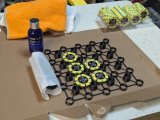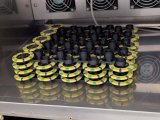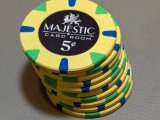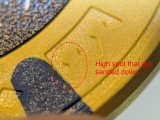I recently purchased a 1200 piece set of Bank series China Clays from Apache Poker. To complement them I wanted some 5 cent chips. I purchased some Majestic 5 cent chips. They are pretty much identical to the Bank series except a different mold and sticker. However, I was not satisfied with how they would slide against each other. They were a little ruff. They were not bad but I felt like the mold had some small high spots around the crown features. See picture after sanding and coating. I wanted to see just how perfectly smooth I could make them.
I took a piece of 800 grit sandpaper, laid it on a flat metal plate and gently rubbed the chips against the sand paper for a few seconds each side. I washed them with soap, water and a scrub brush then let them dry on a towel over night. You could not see a difference in the chip with the naked eye but the results were they were very smooth when sliding against each other. However they would stick together a bit. They would grip to each other. I tried drying them in my thermal chamber at 60C @ 12%RH for 24 hours but no change is grip. Also fyi by weight there was also no change in moisture content. I 3D printed a rack for the chips to sit on and dry
I applied Stibnite's Compression Oiling method to a stack of 20. They looked nice and felt nice however it did not help them gripping to each other. It probably made it worse.
I recently had my new car professionally ceramic coated and wow is it nice. It's very smooth and nothing sticks to it. So I purchased a very cheap but highly rated bottle of ceramic coat for $20. I assume it is far inferior to what was put on my car but for the price I thought I would give it a try.
I sanded the remaining 80 Majestic 5 cent chips, cleaned and dried them. I applied the ceramic coat with the applicator that came in the bottle. Applied it to 20 chips then wiped them with a microfiber cloth and dried them on my rack in the thermal chamber at 40C overnight. I tested a few prematurely after 30 minutes of drying and the results were just like the oiled chips.
After drying overnight I tested the chips in stacks. They were definitely better. I thought they would be slicker. I don't know just how good that $20 bottle of ceramic coating is. I think they came out just right. They no longer grip to each other but they are not slippery like a plastic chip. They are not a slippery and hard as I though they would be. They are still very much like a clay chip not a ceramic chip. They have some friction between them but not a large amount of "starting" friction. They have a more smooth and consistent friction.
I am very pleased with the results. The point was to make them smooth and have the right amount of slide or grip to each other. It does make them look nice and they will probably
I will not invest the time to do this to a whole set but for 100 to 200 chips it was worth it. I do get the irony of buying clay chips and then coating them in "ceramic".
I took a piece of 800 grit sandpaper, laid it on a flat metal plate and gently rubbed the chips against the sand paper for a few seconds each side. I washed them with soap, water and a scrub brush then let them dry on a towel over night. You could not see a difference in the chip with the naked eye but the results were they were very smooth when sliding against each other. However they would stick together a bit. They would grip to each other. I tried drying them in my thermal chamber at 60C @ 12%RH for 24 hours but no change is grip. Also fyi by weight there was also no change in moisture content. I 3D printed a rack for the chips to sit on and dry
I applied Stibnite's Compression Oiling method to a stack of 20. They looked nice and felt nice however it did not help them gripping to each other. It probably made it worse.
I recently had my new car professionally ceramic coated and wow is it nice. It's very smooth and nothing sticks to it. So I purchased a very cheap but highly rated bottle of ceramic coat for $20. I assume it is far inferior to what was put on my car but for the price I thought I would give it a try.
I sanded the remaining 80 Majestic 5 cent chips, cleaned and dried them. I applied the ceramic coat with the applicator that came in the bottle. Applied it to 20 chips then wiped them with a microfiber cloth and dried them on my rack in the thermal chamber at 40C overnight. I tested a few prematurely after 30 minutes of drying and the results were just like the oiled chips.
After drying overnight I tested the chips in stacks. They were definitely better. I thought they would be slicker. I don't know just how good that $20 bottle of ceramic coating is. I think they came out just right. They no longer grip to each other but they are not slippery like a plastic chip. They are not a slippery and hard as I though they would be. They are still very much like a clay chip not a ceramic chip. They have some friction between them but not a large amount of "starting" friction. They have a more smooth and consistent friction.
I am very pleased with the results. The point was to make them smooth and have the right amount of slide or grip to each other. It does make them look nice and they will probably
I will not invest the time to do this to a whole set but for 100 to 200 chips it was worth it. I do get the irony of buying clay chips and then coating them in "ceramic".




